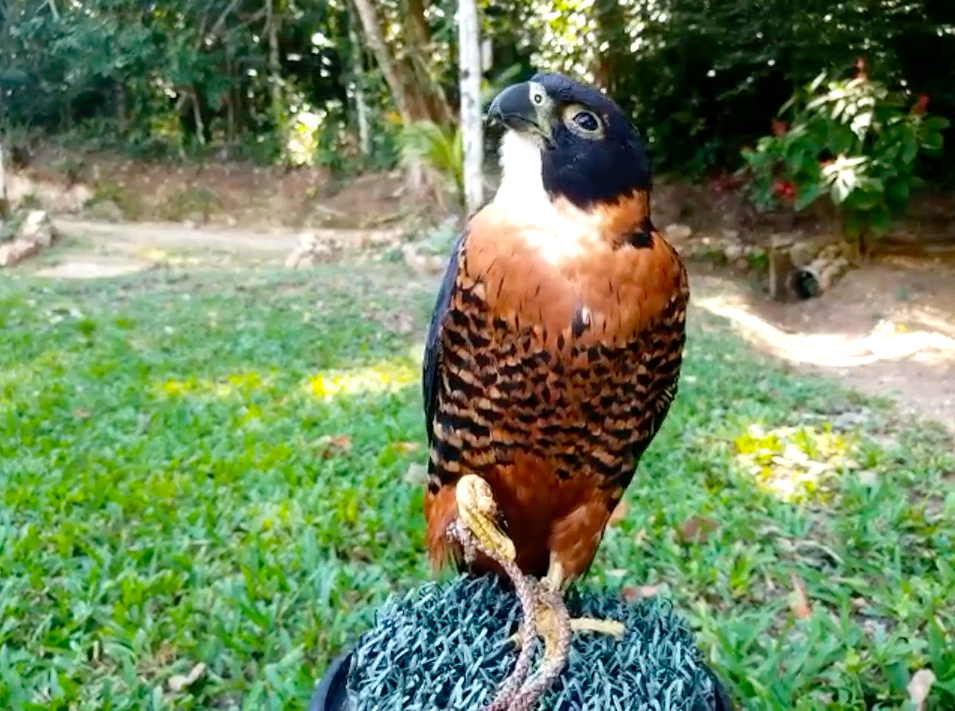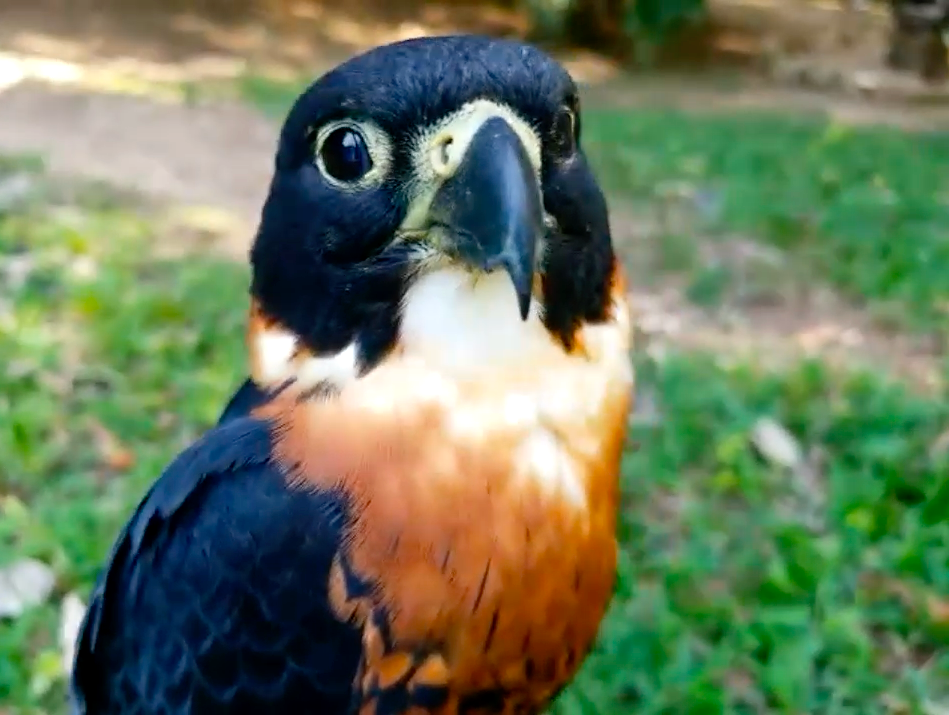The Science of Orange-Breasted Falcons: The Vulnerable Raptors of the Rainforest
Our November Animal of the Month is the Orange-Breasted falcon. We’ve had the opportunity to learn about these amazing raptors through our interactions with the Maya, the ambassador for her species, at the Belize Raptor Center. We were inspired by our visit, and we want you to learn more about her species so that we can help preserve them for future generations.
WHAT ARE ORANGE-BREASTED FALCONS?
The orange-breasted falcon (Falco deiroleucus) is a medium-sized raptor found in the tropics of Central and South America. Though formerly widespread, orange-breasted falcon numbers are shrinking, and are especially vulnerable in Belize and Guatemala.
Maya, an orange-breasted falcon at the Belize Raptor Center. Image by Inspire EdVentures.
Orange-breasted falcons have dark-colored head, wings, and tail feathers, with light throat patches and orange chests and undersides barred (checkered) black. Both the bill and feet are noticeably large; in fact, orange-breasted falcons have the greatest feet-to-body ratio of any bird of prey! Orange-breasted falcons have a wingspan of up to 33 inches (84 cm), a body length of up to 16 inches (41 cm), and can weigh 1.5 pounds (0.7 kg). Female orange-breasted falcons may measure up to twice the size of males.
The shape of an orange-breasted falcon reveals its function. Orange-breasted falcon wings are long and narrow, allowing the falcon to speed quickly after its prey. The falcon’s powerful beak, legs, and talons are employed in both catching prey and defending the falcon and its nest. Even the difference in size between female and male orange-breasted falcons is useful, as it allows them to pursue differently sized prey.
In the wild, orange-breasted falcons are often confused for bat falcons (Falco rufigularis) due to overlap in range and similarities in coloration. Bat falcons are smaller but much more common than orange-breasted falcons, making amateur sightings of the latter difficult to confirm.
A bat falcon, Falco rufigularis. Bat falcons and orange-breasted falcons are often mistaken because of similarities in appearance. Image by Joao Quental.
WHERE DO ORANGE-BREASTED FALCONS LIVE?
Historically, orange-breasted falcons have been found from southern Mexico, throughout Central America, and well into South America. In recent decades, however, that range has become significantly reduced.
Today, the Central American population of orange-breasted falcons is limited to two countries, Belize and Guatemala. The South American population, centered in the Amazon Basin, is larger and more robust. Orange-breasted falcons are most commonly found in Brazil, Bolivia, Paraguay, and Argentina, but have been sighted in countries as far north as Panama and as far south as Chile. However, the Central American and South American populations remain isolated from one another, separated by a distance of nearly 1000 miles (1600 km).
The orange-breasted falcon’s rarity may be driven by its specific requirements for habitat. Orange-breasted falcons are always found near large cliffs, where they make their nests. They prefer unbroken expanses of mature forest, and are rarely found near human settlements or construction. However, habitat alone cannot explain the falcon’s rarity; while suitable habitat for orange-breasted falcons has been found by surveys of Central American countries such as Nicaragua, Honduras, and Costa Rica, the bird itself is absent. Orange-breasted falcons are estimated to occupy less than five percent of their former Central American range.
The Maya Mountains of Belize. This mountain range offers habitat for the orange-breasted falcons, and is believed to mark the southern edge of the Central American population’s range. Photo by Inspire EdVentures.
A 2009 study of the orange-breasted falcon’s presence in Central America estimated a population of less than 40 breeding pairs in Belize and Guatemala. The Peregrine Fund believes the current population may be even lower, with perhaps as few as 20 pairs remaining in the area. The overall population of orange-breasted falcons is still unknown.
HOW DO ORANGE-BREASTED FALCONS BEHAVE?
Orange-breasted falcons are carnivorous and territorial birds of prey. Unlike many other raptor species, which may target ground-dwelling animals such as small reptiles or mammals, orange-breasted falcons almost exclusively hunt other birds. These swift fliers, whose eyesight is up to eight times sharper than a human’s, will often pursue their prey high above the canopy before diving to use their powerful talons and beaks to snare and quickly make work of their catch.
An orange-breasted falcon perched on a branch. Image by Simon Speich.
Orange-breasted falcons mate in pairs and defend a territory. Despite the difference in size between male and female falcons, pairs have been observed hunting and defending their nests together.
Orange-breasted falcons nest in hollows or ledges of rocky cliffs, which offer some protection against predators, or more rarely in large trees. The female falcon lays three eggs over a period of six days (interestingly, this differs from many other falcon species, which lay clutches of four eggs over seven days), and will lay a second clutch if the first is predated or otherwise lost. The female incubates the eggs for up to 30 days, during which time the male falcon will hunt and return to the nest with food. Young falcons fledge (begin to fly) an additional 40 days after hatching, but will remain in the parents’ territory for a period of several months.
The overall lifespan of orange-breasted falcons is unknown, but based on similar falcon species, they may be able to live up to 20 years in captivity. Young falcons reach maturity at around two years of age.
Though orange-breasted falcons are predators themselves, they occasionally become prey to larger species. Eggs and nestlings are most vulnerable, with threats including snakes, small mammals, and other birds such as hawks, owls, and vultures. The bird that poses perhaps the largest threat to orange-breasted falcons is the black vulture (Coragyps atratus). Black vultures are known to prey on orange-breasted falcon nests and even take over those nests for their own use, causing damage to an already threatened population.
A pair of black vultures. Image by Gary Leavens.
ARE ORANGE-BREASTED FALCONS ENDANGERED?
Orange-breasted falcons are listed as Near Threatened by the IUCN. The overall species population is in decline, largely due to habitat loss and fragmentation driven by deforestation of the Amazon Basin. Over the next eighteen years, over a fourth of the orange-breasted falcon’s available habitat may be lost.
This projected trend, though troubling on its own, may not encompass the full story of the threats faced by the orange-breasted falcon. Though the falcon’s population in its South American range is shrinking, the falcon’s Central American population faces far more uncertainty.
Central American orange-breasted falcons have multiple factors stacked against them. First, the population is small and still decreasing; this limits genetic diversity and can lead to inbreeding, which can reduce individual fitness and success of offspring. Because of the large distance between the Central American and South American populations, gene flow or migration between the two is nonexistent without human intervention. Additionally, orange-breasted falcons are specialized to specific environments; they only live near the cliffs that provide their nesting sites, and they are specialized hunters of limited prey. Though orange-breasted falcons have occasionally been seen near human habitation or agriculture sites, the ability of this species to survive near humans long-term is uncertain.
Human presence costs orange-breasted falcons even more than their habitats. Encroachment of black vultures, known predators of orange-breasted falcon eggs and young, may be linked to humans, as black vultures are more able to live in proximity to humans than the falcons. Studies conducted in the 1990s and 2000s found that several known orange-breasted falcon nesting sites in Belize had been overtaken by black vultures, and black vultures and orange-breasted falcons were observed in competition over nesting sites in Tikal National Park in Guatemala. In Belize, during the same period, overall nest and territory occupancy both declined.
Small, isolated, and confronted by increasingly severe human encroachment and habitat destruction, the Central American population of orange-breasted falcons requires significant intervention to survive.
A male orange-breasted falcon. Image by user Arpiapty.
Since 2007, the Peregrine Fund has partnered with the Wolf Creek Charitable Foundation of Sheridan, Wyoming for a captive-breeding program intended to bolster the Belizean orange-breasted falcon population. Orange-breasted falcons were bred and carefully raised in the United States, then released to the wild in Belize.
The Belize Raptor Center became a partner after the organization’s founding in 2012, and, in conjunction with the breeding program, has implemented an education program helped to teach local communities about the struggles and ecological importance of these falcons. In many rural communities, raptors are seen as vermin or potential predators of livestock such as chickens, and are often intentionally killed. The Belize Raptor Center works to change these misconceptions through their resident raptors, who act as educational ambassadors for their species.
Maya, an orange-breasted falcon at the Belize Raptor Center. Maya was initially part of the Peregrine Fund and Belize Raptor Center’s captive breeding program, but an eye defect left her unable to be released to the wild. Instead, Maya became an ambassador for her species at the Belize Raptor Center. Photo by Inspire EdVentures.
Learn more about the orange-breasted falcon and the Belize Raptor Center at Raptors Live!
REFERENCES AND FURTHER READING
Orange-Breasted Falcons at the Peregrine Fund
The Orange-Breasted Falcon Project
Baker, A., Whitacre, D., Aguirre-Barrera, O., & White, C. (2000). The Orange-breasted Falcon Falco deiroleucus in Mesoamerica: A vulnerable, disjunct population? Bird Conservation International, 10(1), 29-40. doi:10.1017/S0959270900000034
Berry, R., Benkman, C., Muela, A., Seminario, Y., Curti, M. (2010). Isolation and Decline of a Population of the Orange-Breasted Falcon, The Condor, 112(3) Issue 3, 79–489. https://doi.org/10.1525/cond.2010.100012
BirdLife International. 2016. Falco deiroleucus. The IUCN Red List of Threatened Species 2016: e.T22696516A93569126. https://dx.doi.org/10.2305/IUCN.UK.2016-3.RLTS.T22696516A93569126.en.







